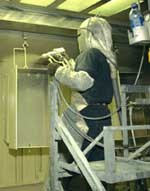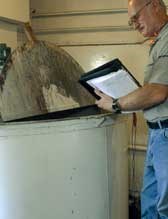A Baffling Development
When The HON Company, one of the world’s largest manufacturers of office furniture and components, realized that 50% of the paint it was applying was being lost in overspray, it turned to an industry supplier for an innovative solution…
In competitive industries, new technologies in product development, manufacturing and delivery are highly prized property. Some developments are the result of creative “accidents,” some come from methodical trials in continuous improvement. At The HON Company, the latter has spurred manufacturing advances that have earned the company high marks for responsiveness to environmental concerns, while building efficiency and profit.
The HON Company is one of the world’s largest manufacturers of office furniture and components. Its parent company, HON INDUSTRIES, has been recognized as one of the most admired companies in the furniture industry according to FORTUNE magazine’s annual survey (March 2003) of 10,000 executives, directors and securities analysts.
Welcome! You’ve unlocked premium content.
In addition to this distinction, The HON Company has an established track record for its aggressive performance in incorporating environmentally friendly technology in day-to-day operations. Much of its success comes from internal resources and an ongoing commitment to conducting business in a way that sustains the well being of society, the environment and the economy. The HON Company also credits associations with suppliers who have played an integral role in the company’s success. One of these partnerships, a long-standing relationship with The Sherwin-Williams Company, has helped The HON Company meet strict environmental regulations, as well as achieve status as the first on-site high-solids reclamation program in the office products industry.
Recycling Paint, Reduces Waste
Like many manufacturers that finish products with coatings, The HON Company was constantly dealing with the costs associated with disposing of unused paint discarded as waste. Adding to the inefficiency was the actual cost of the paint itself. For years, The HON Company used PERMACLAD®, a high-solids solvent-borne coating for its metal office furnishing line. The high-solids solvent paint provided the tough quality and attractive finish The HON Company required. However, about 50% of the paint was being lost in overspray during the application process. The HON Company managers at the Cedartown, Georgia, plant contacted the paint manufacturer, Sherwin-Williams, for a solution to the waste problem.
The Design Engineering Group, a unit at the Sherwin-Williams Chemical Coatings Division, worked with The HON Company to develop a unique filtration system using lightweight steel baffles to collect paint overspray. Today, the baffles are custom-made at The HON Company facilities in various shapes such as an inverted pyramid or tornado-type configuration. To make the baffles easy to use in various applications, they are vertically mounted on moveable wall units that are placed directly in front of the air filtration and exhaust system in each spray booth.
The baffle system was developed specifically for the high solids coating that remains tacky until it is exposed to curing ovens following application. Over the years, the coating’s VOC content has been reduced, but its formulation still makes it ideal for the paint recycling process. As paint is being applied with electrostatic spray equipment, overspray is drawn into the baffles where it collects. The coating drips into collection troughs and then is pumped into 55-gallon drums. Recovered paint is sent to an on-site paint shop where it is recycled.
Reconstituting Paint
Reconstituting the paint involves a series of steps engineered by Sherwin-Williams specifically for The HON Company. Based on the four pigments that the company uses for its products, reclaimed paint usually falls into one of two color groups—light or dark gray. After paint colors have been separated, they go through a series of measurements that determine their solids content. The reclaimed paint is then reduced to the desired VOC and viscosity using approved solvents. Sherwin-Williams technicians work onsite at The HON Company facilities to assist The HON Company personnel with reconstituted paint to meet quality requirements for product standards and environmental regulations.
To achieve the desired coating colors, the technicians use spectrophotometers and Sherwin-Williams color-matching software to obtain color matches to the original paint. By identifying the pigments in the recovered paint, technicians are able to compare that to the type of colorants needed to create the original base color. Sophisticated computer programs allow the color matching and reconstituting process to take place quickly, enabling the paint to be used again on the line.
Exacting data supplied by the software program and oversight by knowledgeable technicians, also guarantees that the reconstituted paint will have the same performance characteristics as the original paint. The HON Company also takes the time to test each batch on panels. According to Bill McClure, environmental coordinator at The HON Company facility in Cedartown, Georgia, painters who work on the line are very aware of changes in paint viscosity and other differences. However, McClure says, “Painters can’t detect any differences between the reconstituted paint and the original.”
Enhancing the Bottom Line
The company’s reclamation program has had a range of benefits from practical day-to-day measures, to huge cost savings and substantial reduction in waste production. One of the first advantages is reduction in booth clean up on the finishing line. Using the baffle system, booth maintenance is greatly reduced since reclaimed paint doesn’t need to be cleaned away. In addition, according to Scott Lesnet, safety and environmental manager for HON INDUSTRIES, the most dramatic benefit of recycling paint is waste reduction. “Benefits for recycling are great for the environment and for HON,” Lesnet observes. “With our system, we’re attaining more than 90% in reuse of product.”
Recycling also dramatically reduces costs associated with waste disposal. Before the HON Company’s effort to reclaim the paint, the company spent hundreds of dollars per drum to dispose of old paint. And, with each facility easily producing six to seven drums of paint waste a day, removal costs for the year were staggering.
Another benefit is industry recognition as one of the country’s leaders in the use of environmentally sound practices. Most recently, HON INDUSTRIES was awarded the prestigious Evergreen Furniture Award from the General Services Administration National Furniture Center, a procurement division for the Federal Government in Washington, D.C. The award is based on the performance of two of HON INDUSTRIES’ operating companies, Allsteel Inc. and The HON Company. The annual award is given to the company that exhibits the highest levels of environmentally responsible practices. “Our goal in all aspects of the manufacturing process is to have minimal environmental impact,” Lesnet says. “With these types of programs in place, we can realize some very positive effects now and in the future.”
Related Content
Zinc Phosphate: Questions and Answers
Our experts share specific questions about zinc phosphate and pretreatment
Read MoreNovel Wastewater Treatment Targets Micropollutants
Swiss wastewater treatment technology provider Oxyle specializes in advanced wastewater treatment for removal of highly persistent micropollutants such as PFAS.
Read MoreHubbard-Hall Acquires BioConversion Technology
The acquisition adds experience and biologics to the AquaPure product line.
Read MoreNASF/AESF Foundation Research Project #122: Electrochemical Approaches to Treatment of PFAS in Plating Wastewater - 7th Quarterly Report
The NASF-AESF Foundation Research Board has selected a project on addressing the problem of PFAS and related chemicals in plating wastewater streams, studying PFAS destruction via electrooxidation and electrocoagulation. Our last report described the results from experiments of EO with a Magnéli phase Ti4O7 anode on the degradation of eight perfluoroalkyl acids (PFAAs). In this seven quarter report, we describe work to further explore how the degradation of different PFAAs are related to their molecular structures.
Read MoreRead Next
Delivering Increased Benefits to Greenhouse Films
Baystar's Borstar technology is helping customers deliver better, more reliable production methods to greenhouse agriculture.
Read MoreEpisode 45: An Interview with Chandler Mancuso, MacDermid Envio Solutions
Chandler Mancuso, technical director with MacDermid Envio discusses updating your wastewater treatment system and implementing materials recycling solutions to increase efficiencies, control costs and reduce environmental impact.
Read MoreEducation Bringing Cleaning to Machining
Debuting new speakers and cleaning technology content during this half-day workshop co-located with IMTS 2024.
Read More
























